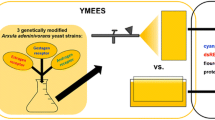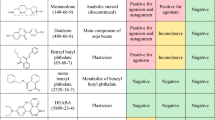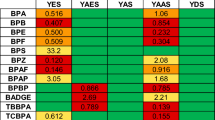Abstract
Background, aim and scope
Estrogenic and non-estrogenic chemicals typically co-occur in the environment. Interference by non-estrogenic chemicals may confound the assessment of the actual estrogenic activity of complex environmental samples. The aim of the present study was to investigate whether, in which way and how seriously the estrogenic activity of single estrogens and the observed and predicted joint action of estrogenic mixtures is influenced by toxic masking and synergistic modulation caused by non-estrogenic chemical confounders.
Materials and methods
The yeast estrogen screen (YES) was adapted so that toxicity and estrogenicity could be quantified simultaneously in one experimental run. Mercury, two organic solvents (dimethyl sulfoxide (DMSO) and 2,4-dinitroaniline), a surfactant (LAS-12) and the antibiotic cycloheximide were selected as toxic but non-estrogenic test chemicals. The confounding impact of selected concentrations of these toxicants on the estrogenic activity of the hormone 17ß-estradiol was determined by co-incubation experiments. In a second step, the impact of toxic masking and synergistic modulation on the predictability of the joint action of 17ß-estradiol, estrone and estriol mixtures by concentration addition was analysed.
Results
Each of the non-estrogenic chemicals reduced the apparent estrogenicity of both single estrogens and their mixtures if applied at high, toxic concentrations. Besides this common pattern, a highly substance- and concentration-dependent impact of the non-estrogenic toxicants was observable. The activity of 17ß-estradiol was still reduced in the presence of only low or non-toxic concentrations of 2,4-dinitroaniline and cycloheximide, which was not the case for mercury and DMSO. A clear synergistic modulation, i.e. an enhanced estrogenic activity, was induced by the presence of slightly toxic concentrations of LAS-12. The joint estrogenic activity of the mixture of estrogens was affected by toxic masking and synergistic modulation in direct proportion to the single estrogens, which allowed for an adequate adaptation of concentration addition and thus unaffected predictability of the joint estrogenicity in the presence of non-estrogenic confounders.
Discussion
The modified YES proved to be a reliable system for the simultaneous quantification of yeast toxicity and estrogen receptor activation. Experimental results substantiate the available evidence for toxic masking as a relevant phenomenon in estrogenicity assessment of complex environmental samples. Synergistic modulation of estrogenic activity by non-estrogenic confounders might be of lower importance. The concept of concentration addition is discussed as a valuable tool for estrogenicity assessment of complex mixtures, with deviations of the measured joint estrogenicity from predictions indicating the need for refined analyses.
Conclusions
Two major challenges are to be considered simultaneously for a reliable analysis of the estrogenic activity of complex mixtures: the identification of known and suspected estrogenic compounds in the sample as well as the substance- and effect-level-dependent confounding impact of non-estrogenic toxicants.
Recommendations and perspectives
The application of screening assays such as the YES to complex mixtures should be accompanied by measures that safeguard against false negative results which may be caused by non-estrogenic but toxic confounders. Simultaneous assessments of estrogenicity and toxicity are generally advisable.




Similar content being viewed by others
References
Beck IC, Bruhn R, Gandrass J (2006) Analysis of estrogenic activity in coastal surface waters of the Baltic Sea using the yeast estrogen screen. Chemosphere 63(11):1870–1878
Berenbaum MC (1985) The expected effect of a combination of agents: the general solution. J Theor Biol 114:413–431
Beresford N, Routledge EJ, Harris CA, Sumpter JP (2000) Issues arising when interpreting results from an in vitro assay for estrogenic activity. Toxicol Appl Pharmacol 162:22–33
Coldham NG, Dave M, Silvapathasundaram S, McDonnel DP, Connor C, Sauer MJ (1997) Evaluation of a recombinant yeast cell estrogen screening assay. Environ Health Perspect 105:734–742
Cooper TG, Bossinger J (1976) Selective inhibition of protein synthesis iniation in Saccharomyces cerevisiae by low concentrations of cycloheximide. J Biol Chem 251(22):7278–7280
Coors A, Jones PD, Giesy JP, Ratte HT (2003) Removal of estrogenic activity from municipal waste landfill leachate assessed with a bioassay based on reporter gene expression. Environ Sci Technol 37:3430–3434
de Boever P, Demare W, Vanderperren E, Cooreman K, Bossier P, Verstraete W (2001) Optimization of a yeast estrogen screen and its applicability to study the release of estrogenic isoflavones from a soygerm powder. Environ Health Perspect 109:691–697
Fang H, Tong W, Perkins R, Soto AM, Prechtl N, Sheehan DM (2000) Quantitative comparisons of in vitro assays for estrogenic activities. Environ Health Perspect 108:723–729
Faust M, Altenburger R, Backhaus T, Blanck H, Boedeker W, Gramatica P, Hamer V, Scholze M, Vighi M, Grimme LH (2003) Joint algal toxicity of 16 dissimilarly acting chemicals is predictable by the concept of independent action. Aquat Toxicol 63:43–63
Freyberger A, Schmuck G (2005) Screening for estrogenicity and anti-estrogenicity: a critical evaluation of an MVLN cell-based transactivation assay. Toxicol Lett 155(1):1–13
Greenspan FS, Gardner DG (eds) (2004) Basic and clinical endocrinology. Seventh edition. Lange Medical Books/McGraw-Hill, New York. 976 pp
Hamblen EL, TD CM, Schultz TW (2003) Estrogenicity and acute toxicity of selected anilines using a recombinant yeast assay. Chemosphere 52:1173–1181
Harris CA, Brian JV, Pojona G, Lamoree M, Booy P, Marcomini A, Sumpter JP (2009) The influence of a surfactant, linear alkylbenzene sulfonate, on the estrogenic response to a mixture of (xeno) estrogens in vitro and in vivo. Aquat Toxicol 91(1):95–98
Hutchinson TH, Shillabeer N, Winter MJ, Pickford DB (2006) Acute and chronic effects of carrier solvents in aquatic organisms: a critical review. Aquatic Toxicol 76(1):69–92
ISO 7027 (1999) Water quality—determination of turbidity. International Organisation for Standardisation
Iwahashi H, Fujita K, Takahashi Y (2000) Bioassay for chemical toxicity using yeast Saccharomyces cerevisiae. Water Sci Technol 42(7–8):269–276
Kase R, Hansen PD, Fischer B, Manz W, Heininger P, Reifferscheid G (2008) Integral assessment of estrogenic potentials of sediment-associated samples, part 1: the influence of salinity on the in vitro tests ELRA, E-Screen and YES. Environ Sci Pollut Res 15(1):75–83
Knight AW, Keenan PO, Goddard NJ, Fielden PR, Wamsley RM (2004) A yeast-based cytotoxicity and genotoxicity assay for environmental monitoring using novel portable instrumentation. J Environ Monit 6:71–79
Kortenkamp A (2007) Ten years of mixing cocktails—a review of endocrine disrupter mixture effects. Environ Health Perspect 114:752–758
Matthijs E, Holt MS, Kiewiet A, Rijs GBJ (1999) Environmental monitoring for linear alkylbenzene sulfonate, alcohol ethoxylate, alcohol ethoxy sulfate, and soap. Environ Toxicol Chem 18:2634–2644
Miller D, Wheals BB, Beresford N, Sumpter J (2001) Estrogenic activity of phenolic additives determinded by an in vitro yeast bioassay. Environ Health Perspect 109:133–138
Müller M, Herrchen M (2002) Ranking der prioritären Stoffe der Wasserrahmenrichtlinie sowie sonstiger Schadstoffe hinsichtlich ihrer Relevanz in Deutschland bzw. in einzelnen Flusseinzugsgebieten. Umweltbundesamt, Berlin
Murk AJ, Legler J, van Lipzig MMH, Meermann HN, Belfroid AC, Spenkelink A, van der Burg B, Rijs GBJ, Vethaak D (2002) Detection of estrogenic potency in wastewater and surface water with three in vitro bioassays. Environ Toxicol Chem 21:16–23
Nakada N, Nyunoya H, Nakamura M, Hara A, Iguchi T, Takada H (2004) Identification of estrogenic compounds in wastewater effluent. Environ Toxicol Chem 23:2807–2815
Payne J, Rajapakse N, Wilkins M, Kortenkamp A (2000) Prediction and assessment of the effects of mixtures of four xenoestrogens. Environ Health Perspect 108:983–987
Peck M, Gibson RW, Kortenkamp A, Hill EM (2004) Sediments are major sinks of steroidal estrogens in two United Kingdom rivers. Environ Toxicol Chem 23:945–952
Rajapakse N, Ong D, Kortenkamp A (2001) Defining the impact of weakly estrogenic chemicals on the action of steroidal estrogens. Toxicol Sci 60:296–304
Routledge E, Sumpter JP (1996) Estrogenic activity of surfactants and some of their degradation products assessed using a recombinant yeast screen. Environ Toxicol Chem 15:241–248
Rutishauser BV, Pesonen M, Escher BI, Ackermann GE, Aerni HR, Suter MJF, Eggen RIL (2004) Comparative analysis of estrogenic activity in sewage treatment plant effluents involving three in vitro assays and chemical analysis of steroids. Environ Toxicol Chem 23:857–864
Scholze M, Boedeker W, Faust M, Backhaus T, Altenburger R, Grimme LH (2001) A general best-fit method for concentration–response curves and the estimation of low-effect concentrations. Environ Toxicol Chem 20:448–457
Schultis T, Metzger JW (2004) Determination of estrogenic activity by LYES-assay (yeast estrogen screen-assay assisted by enzymatic digestion with lyticase). Chemosphere 57:1649–1655
Singer MM, Tjerdema RS (1993) Fate and effects of the surfactant sodium dodecyl sulfate. Rev Environ Contam Toxicol 133:95–149
Snyder SA, Villeneuve DL, Snyder EM, Giesy JP (2001) Identification and quantification of estrogen receptor agonists in wastewater effluents. Environ Sci Technol 35:3620–3625
Sumpter JP (2005) Endocrine disrupters in the aquatic environment: an overview. Acta Hydrochim Hydrobiol 33:9–16
Thorpe KL, Gross-Sorokin M, Johnson I, Brighty G, Tyler CR (2006) An assessment of the model of concentration addition for predicting the estrogenic activity of chemical mixtures in wastewater treatment works effluents. Environ Health Perspect 114(suppl 1):90–97
Vanderperren E, Demare W, Blust R, Cooreman K, Bossier P (2001) Oestrogenic activity of CPRG (chlorophenol red-beta-D-galactopyranoside), a beta-galactosidase substrate commonly used in recombinant yeast oestrogenic assays. Biomarkers 6:375–380
van Ewijk PH, Hoekstra JA (1993) Calculation of the EC50 and its confidence interval when subtoxic stimulus is present. Ecotoxicol Environ Saf 25:25–32
Weber J, Plantikow A, Kreutzmann J (2000) Ein neuer Biotest mit der Hefe Saccharomyces cerevisiae auf aquatische Toxizität. Umweltwiss Schadst Forsch 12(4):185–189
Wind T, Werner U, Jacob M, Hauk A (2004) Environmental concentrations of boron, LAS, EDTA, NTA and Triclosan simulated with GREAT-ER in the river Itter. Chemosphere 54:1135–1144
Acknowledgements
Parts of the work have been carried out under the EU-funded project ACE (EVK1-CT-2001-00100), and financial support from the European Commission is gratefully acknowledged. We thank Erika Lorenz and Marianne Matzke (Bremen University) for their excellent technical support.
Author information
Authors and Affiliations
Corresponding author
Additional information
Responsible editor: Henner Hollert
Electronic supplementary material
Major results of concentration response analyses are graphically presented in this paper. Additional figures as well as tables of the corresponding concentration response models and functions are available in the ESM.
ESM 1
(PDF 116 kb)
Rights and permissions
About this article
Cite this article
Frische, T., Faust, M., Meyer, W. et al. Toxic masking and synergistic modulation of the estrogenic activity of chemical mixtures in a yeast estrogen screen (YES). Environ Sci Pollut Res 16, 593–603 (2009). https://doi.org/10.1007/s11356-009-0184-7
Received:
Accepted:
Published:
Issue Date:
DOI: https://doi.org/10.1007/s11356-009-0184-7




